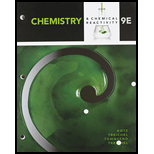
Concept explainers
Calculate the pH after mixing 15 mL of 0.12 M acetic acid with 15 ml of 0.12 M NaOH. What are the major species in solution at equilibrium (besides water), and what are their concentrations?
Interpretation:
The
Concept introduction:
The
Hydronium ion concentration is calculated by considering the equilibrium conditions and from the value of acid dissociation constant.
The concentration of acetic acid and acetate ion is determined by using equilibrium condition The concentration of acetate ion and hydronium ion is equal at equilibrium according to the reaction stoichiometry.
Equilibrium constants:
The equilibrium constant is used to quantitative measurement of the strength of the acid and bases in the water.
The
The sum of
The
Answer to Problem 5CYU
The
The major species except water in the solution at equilibrium are
Explanation of Solution
An equilibrium constant
For any base B, the chemical reaction is written as,
The relative strength of an acid and base in water can be also expressed quantitatively with an equilibrium constant as follows:
An equilibrium constant
Given:
Refer to the table
Dissociation constant
The concentration of
The concentration of
The volume of
The volume of
The balanced chemical equation involving acetic acid and sodium hydroxide is written as,
Amount of
After completion of the reaction, the total volume of solution
The concentration of acetate ion is,
Therefore, the concentration of acetate ion is
Amount of
The concentration of sodium ion is,
Therefore, the concentration of sodium ion is
With the initial concentration of acetate ion is known, set up an ICE table to calculate the equilibrium concentration of hydroxide ion
Substitute the values at equilibrium from the ICE table into equation (3) to calculate the concentration of hydroxide ion,
Substitute the value
The acetate ion is the very weak base. Therefore,
Since the concentration of hydroxide ion is equal to
Substitute the concentration of hydroxide ion into equation (1) to calculate
Substitute the value of
Therefore, the
The major species besides water at equilibrium are
The
The major species besides water in the solution at equilibrium are
Want to see more full solutions like this?
Chapter 16 Solutions
Bundle: Chemistry & Chemical Reactivity, Loose-Leaf Version, 9th + OWLv2, 4 terms (24 Months) Printed Access Card
- Sketch a titration curve for the titration of potassium hydroxide with HCl, both 0.100 M. Identify three regions in which a particular chemical species or system dominates the acid-base equilibria.arrow_forwardCalculate the pH of solutions that are 0.25 M formic acid and 0.40 M sodium formate. 0.50 M benzoic acid and 0.15 M sodium benzoate.arrow_forwardYou dissolve 0.425 g NaOH in 2.00 L of a solution that originally had [H2PO4]=[HPO42] = 0.132 M. Calculate the resulting pH.arrow_forward
- The species called glacial acetic acid is 98% acetic acid by mass (d=1.0542g/mL). What volume of glacial acetic acid must be added to 100.0 mL of 1.25 M NaOH to give a buffer with a pH of 4.20?arrow_forwardA solution is made by diluting 25.0 mL of concentrated HCl (37% by weight; density = 1.19 g/mL) to exactly 500 mL. Calculate the pH of the resulting solution.arrow_forwardThe pH of 0.10 M CH3NH2 (methylamine) is 11.8. When the chloride salt of methylamine, CH3NH3Cl, is added to this solution, does the pH increase or decrease? Explain, using Le Chteliers principle and the common-ion effect.arrow_forward
- Which of these combinations is the best to buffer the pH at approximately 9? Explain your choice. CH3COOH/NaCH3COO HCl/NaCl NH3/NH4Clarrow_forwardCalculate the pH of a solution prepared by mixing 49.0 mL of butyric acid, HC4H7O2, with 6.15 g of KOH in water. The following data about butyric acid may be helpful: density=0.9595g/mL;K a =1.54105arrow_forwardConsider a solution formed by mixing 100.0 mL of 0.10 M HA (Ka = 1.0 106), 100.00 mL of 0.10 M NaA. and 100.0 mL of 0.10 M HCl. In calculating the pH for the final solution, you would make some assumptions about the order in which various reactions occur to simplify the calculations. State these assumptions. Does it matter whether the reactions actually occur in the assumed order? Explain.arrow_forward
 Chemistry & Chemical ReactivityChemistryISBN:9781337399074Author:John C. Kotz, Paul M. Treichel, John Townsend, David TreichelPublisher:Cengage Learning
Chemistry & Chemical ReactivityChemistryISBN:9781337399074Author:John C. Kotz, Paul M. Treichel, John Townsend, David TreichelPublisher:Cengage Learning Chemistry: Principles and PracticeChemistryISBN:9780534420123Author:Daniel L. Reger, Scott R. Goode, David W. Ball, Edward MercerPublisher:Cengage Learning
Chemistry: Principles and PracticeChemistryISBN:9780534420123Author:Daniel L. Reger, Scott R. Goode, David W. Ball, Edward MercerPublisher:Cengage Learning Chemistry: The Molecular ScienceChemistryISBN:9781285199047Author:John W. Moore, Conrad L. StanitskiPublisher:Cengage Learning
Chemistry: The Molecular ScienceChemistryISBN:9781285199047Author:John W. Moore, Conrad L. StanitskiPublisher:Cengage Learning Chemistry: Principles and ReactionsChemistryISBN:9781305079373Author:William L. Masterton, Cecile N. HurleyPublisher:Cengage Learning
Chemistry: Principles and ReactionsChemistryISBN:9781305079373Author:William L. Masterton, Cecile N. HurleyPublisher:Cengage Learning Living By Chemistry: First Edition TextbookChemistryISBN:9781559539418Author:Angelica StacyPublisher:MAC HIGHER
Living By Chemistry: First Edition TextbookChemistryISBN:9781559539418Author:Angelica StacyPublisher:MAC HIGHER ChemistryChemistryISBN:9781305957404Author:Steven S. Zumdahl, Susan A. Zumdahl, Donald J. DeCostePublisher:Cengage Learning
ChemistryChemistryISBN:9781305957404Author:Steven S. Zumdahl, Susan A. Zumdahl, Donald J. DeCostePublisher:Cengage Learning





